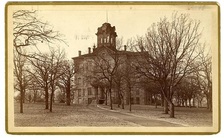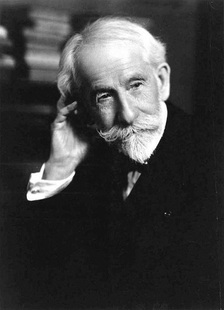In addition to mandating an exhaustive study of the geological, botanical, and zoological phenomena of the state, the March 1, 1872 law that created the Minnesota Geological and Natural History Survey under the authority of the Board of Regents of the University of Minnesota also indicated precise terms for how the efforts of the survey would benefit the citizens of Minnesota.
Section 6 states:
“It shall be the duty of the said board of regents to cause proper specimens, skillfully prepared, secured and labeled of all rocks, soils, ores, coals, fossils, cements, building stones, plants, woods, skins and skeletons of animals, birds, insects and fishes, and other mineral, vegetable and animal substances and organisms discovered or examined in the course of said surveys, to be preserved for public inspection free of cost, in the University of Minnesota, in rooms convenient of access and properly warmed, lighted, ventilated and furnished, and in charge of a proper scientific curator; and they shall also, whenever the same may be practicable, cause duplicated in reasonable numbers and quantities of the above named specimens, to be collected and preserved for the purpose of exchanges with other state universities and scientific institutions, of which latter the Smithsonian Institute at Washington should have preference.”
By April of 1873, after one full season of survey work was complete by the appointed survey director and State Geologist Newton Horace Winchell, the Board of Regents created the position of the Chair of Geology and elected Winchell to the position. When the governing body met again that month, they gave the Chair of Geology an added title: “curator of the museum.”
In the “Report of the Curator of the Museum” found in the Annual Report of the Board of Regents for 1873, Winchell indicated the primitive state of the “disorganized” museum, and expressed the need for adequate storage facilities. He also described the necessity of procuring proper record books and a system of labeling in order to organize the collection. Prior to providing a full list of existing specimens in the museum collection, Winchell described the state in which he found them:
Upon examination of the boxes and open shelving holding the specimens of the Museum, it was found that there were more specimens than had ever been recorded, and that they were all in more or less confusion. Some of them were utterly uncared for, unlabeled and unboxed, the donors’ names, if they ever were known, having been lost, the localities whence derived in many cases obscurely remembered or unknown, and their value for all purposes much diminished. No records had been preserved.
He reported that materials collected as part of the geological survey were kept separate from the existing disorganized museum collection, and were carefully wrapped and maintained by himself and Professor Peckham, an instructor of Chemistry who also served as chemist for the survey. Winchell indicated that “the private collections of Professor Peckham and myself would be placed on exhibition in the University of Minnesota if the necessary means for their security were taken by the Board of Regents.”
The means for the security and exhibition of museum specimens was on an ever-growing list of necessary upgrades to University facilities in the 1870s, due in part to the fact that the University itself had just emerged from a state of more or less confusion…
 The University of Minnesota was established as a preparatory school by an act of the territorial legislature in 1851 (Minnesota received territorial designation a mere two years prior in 1849). Within the first several years of the school’s existence, it became necessary to construct a larger university building to accommodate students and faculty. The Board of Regents received an appropriation from the legislature in order to do so. However, the appropriation and building construction coincided with an economic downturn in 1857. As a result, only one wing of the planned building was erected and an unfinished section was hastily boarded up. As James Gray described in The University of Minnesota 1851-1951, “there the fragment stood, looking as blighted as the financial outlook of the times in which it was built.”
The University of Minnesota was established as a preparatory school by an act of the territorial legislature in 1851 (Minnesota received territorial designation a mere two years prior in 1849). Within the first several years of the school’s existence, it became necessary to construct a larger university building to accommodate students and faculty. The Board of Regents received an appropriation from the legislature in order to do so. However, the appropriation and building construction coincided with an economic downturn in 1857. As a result, only one wing of the planned building was erected and an unfinished section was hastily boarded up. As James Gray described in The University of Minnesota 1851-1951, “there the fragment stood, looking as blighted as the financial outlook of the times in which it was built.”
The state of the building, in many respects, symbolized the future of the preparatory school. In the years following the economic downturn, the nation was in the midst of the Civil War, and the University, unable to pay for construction of the university building, carried a substantial debt. It wasn’t until in 1867, nearly a decade later, that Board of Regents member John Pillsbury worked to settle the University’s debts through the sale of lands granted to the state by Congress. In the same year, Pillsbury requested a $15,000 appropriation from the state legislature in order to repair the university building. The appropriation was granted, and courses resumed at the University in the fall of 1867. In 1869, the first President of the University of Minnesota was elected: William Watts Folwell.
With a finished building, faculty, students, and a new President, the University began to slowly develop as a formal institution of higher education, though it faced many growing pains as it progressed. Space was at a premium in the university building. In order to accommodate incoming students, academic units, the library, an agricultural laboratory, and the apparatus and storage needed by the State Geologist to conduct the geological survey, an appropriation was made by the state legislature to use towards the expansion of facilities.
 Expansion proved difficult however, as the contractors that were hired to build an addition to the university building (later referred to as “Old Main”) proved to be inferior. As President Folwell (at left) relayed to the Board of Regents in the 1874 annual report, the contractors “significantly failed to complete the work, interfering with the internal development of the institution, causing the failure of accommodations for the library and geological museum, and completely debarring the professors and students from the use of the laboratory for experiments in chemistry and agriculture.”
Expansion proved difficult however, as the contractors that were hired to build an addition to the university building (later referred to as “Old Main”) proved to be inferior. As President Folwell (at left) relayed to the Board of Regents in the 1874 annual report, the contractors “significantly failed to complete the work, interfering with the internal development of the institution, causing the failure of accommodations for the library and geological museum, and completely debarring the professors and students from the use of the laboratory for experiments in chemistry and agriculture.”
The annoyance brought forth by the delay in construction of the university building can be found in the curtness of the “Report of the Chemist” given by Professor Peckham in 1874: “As Chemist of the Geological Survey of the State, I have the honor to report that during the year ending December 31, 1874, no progress whatsoever has been made in the chemical work of the Survey.” Despite inconveniences, Peckham remained determined and added, “no effort will be spared on my part to place this department of the Survey on a proper basis as soon as possible.”
In the “Report of the Museum Curator” for 1874, Winchell relayed that collections were gradually accumulating, and urged the Board of Regents to make “immediate provision for the accommodation of the museum in the University building.” He further referred to the provisions of the 1872 act that created the survey, which required that the collections made in execution of it be exhibited and accessible to the public. He went on to infer that, “The good name of the University and the scientific reputation of the state, are suffering for the want of a room in which to exhibit, and in which to consult these specimens.”
The University cancelled the contract with the original firm hired to construct the addition to “Old Main” and the work was finished by a new firm in 1875. Exhibition space for the specimen collection of the Survey was allocated within the finished building. In the conclusion to the tenth annual Report of the President of the University in 1876, a statement acknowledged the achievement of added facilities to the University of Minnesota:
“The year covered by this report has been a marked one in the history of the University. The occupation of the new buildings has permitted considerable enlargements of our work, and all of it has been done more conveniently for all concerned than ever before… The General Museum, after unavoidable delays, through delinquency of contracts, was opened to the public during the spring term. It is but just to say that the exhibition forms a creditable beginning. The Museum can be, and should be, immediately extended, but to that more room and additional funds are indispensable.”
To surmise that Winchell, the State Geologist, Director of the Survey, Chair of Geology, and “curator of the museum” wholeheartedly agreed with the sentiment conveyed in that report would be an overstatement. Winchell asserted the importance of the museum in his own words:
“The museum is not a mere show, it is an indispensable means of instruction. The sciences properly called ‘natural,’ cannot be taught without specimens any more than the ‘physical’ sciences can be taught without instruments. From written and oral descriptions, and from pictures, the student can learn many things about plants, animals, and rocks, etc., but he cannot be said to know them, until brought into contact with them through his senses. The museum, therefore, as prerequisite to certain scientific study and research demands immediate reinforcement.”
Reinforcement did come to the museum, in due time. The story of the next chapter of the museum’s development will also come, in due time. Stay tuned for the next installment, where we will share the steps that Winchell took to procure specimens and study materials to build the early collection of the “General Museum” at the University of Minnesota.